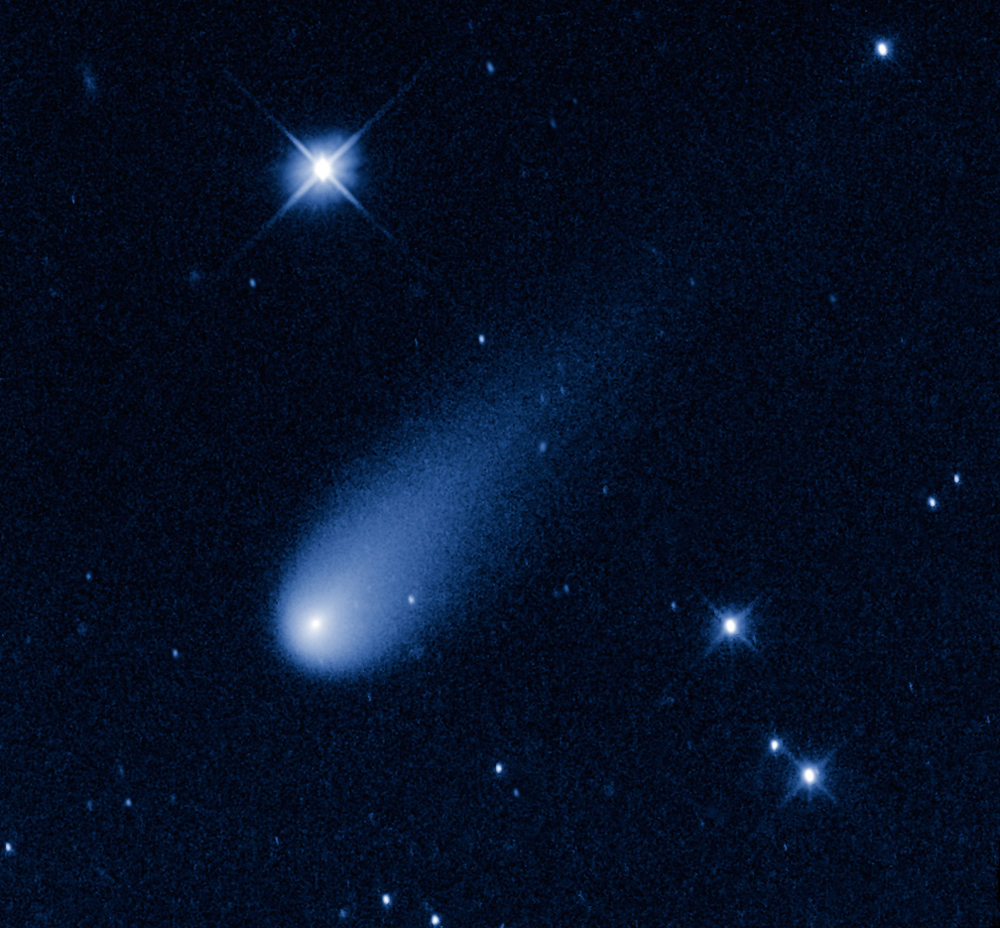
It doesn't look like Comet ISON will live up to the considerable hype, one researcher says.
ISON has been billed as a potential "comet of the century," with some experts saying it could blaze as brightly as the full moon around the time of its close solar approach in late November. But the comet's recent behavior suggests that such a dazzling show is not in the cards, says astronomer Ignacio Ferrín of the University of Antioquia in Medellín, Colombia.
"Comet ISON has presented a peculiar behavior," Ferrín said in a statement Monday (July 29). "The light curve has exhibited a 'slowdown event' characterized by a constant brightness, with no indication of a brightness increase tendency. This slowdown took place around January 13th, 2013. For 132 days after that date and up to the last available observation, the brightness has remained constant." [Photos of Comet ISON: A Potentially Great Comet]
Comet ISON's recent performance has a precedent that's not terribly encouraging. In 2003, Comet C/2002 O4 Hönig exhibited a brightness plateau for 52 days and then disintegrated, Ferrín noted.
"The future of Comet ISON does not look bright," he said.
Comet ISON is slated to skim just 724,000 miles (1.16 million kilometers) above the surface of the sun on Nov. 28. Thus far, most scientists have been hedging their bets about the icy wanderer's performance. It's difficult to predict how any comet will behave during a close solar passage, they say, and especially tough to do so for "dynamically new" comets like ISON that are making their first trip to the inner solar system from the frigid, distant Oort Cloud.

The forecast could start firming up a bit soon, however. Comet ISON — whose nucleus is thought to be just 3 to 4 miles (4.8 to 6.5 km) wide — is slated to cross the "frost line" within the next few weeks, scientists say.
Get the Space.com Newsletter
Breaking space news, the latest updates on rocket launches, skywatching events and more!
This boundary, which lies about 230 to 280 million miles (370 to 450 million km) from the sun, marks the point at which ISON's water ice will start boiling off into space. (Until now, most of its activity has been driven by sublimating carbon dioxide.)
ISON should brighten as it crosses the frost line, and scientists and skywatchers should get a better idea of how tough the comet is, researchers say. Some inbound comets haven't survived their trip past the frost line.
Comet ISON was discovered last September by amateur astronomers Vitali Nevski and Artyom Novichonok. It takes its name from the equipment the duo used — the International Scientific Optical Network (ISON) near Kislovodsk, Russia.
Skywatchers aren't the only people eagerly tracking ISON's journey toward the sun. NASA has organized a coordinated observation campaign enlisting many instruments on the ground and in space. The goal is to learn more about Comet ISON's composition, which could in turn reveal insights about the early days of the solar system.
UPDATE: Scientists will be meeting Thursday (Aug. 1) and Friday (Aug. 2) to form a game plan for observing and studying comet ISON during a workshop at the Johns Hopkins University Applied Physics Laboratory (APL) in Laurel, Md. The workshop will be webcast from 9 a.m. EDT to 5 p.m. EDT both days. You can watch live here on SPACE.com, directly at the workshop homepage, or at LiveStream.
Editor's note: If you snap a photo of Comet ISON or any other amazing night sky object and you'd like to share it for a possible story or image gallery, please send images, comments and details to managing editor Tariq Malik at spacephotos@space.com.
Follow Mike Wall on Twitter @michaeldwall and Google+. Follow us @Spacedotcom, Facebook or Google+. Originally published on SPACE.com.
Join our Space Forums to keep talking space on the latest missions, night sky and more! And if you have a news tip, correction or comment, let us know at: community@space.com.

Michael Wall is a Senior Space Writer with Space.com and joined the team in 2010. He primarily covers exoplanets, spaceflight and military space, but has been known to dabble in the space art beat. His book about the search for alien life, "Out There," was published on Nov. 13, 2018. Before becoming a science writer, Michael worked as a herpetologist and wildlife biologist. He has a Ph.D. in evolutionary biology from the University of Sydney, Australia, a bachelor's degree from the University of Arizona, and a graduate certificate in science writing from the University of California, Santa Cruz. To find out what his latest project is, you can follow Michael on Twitter.











